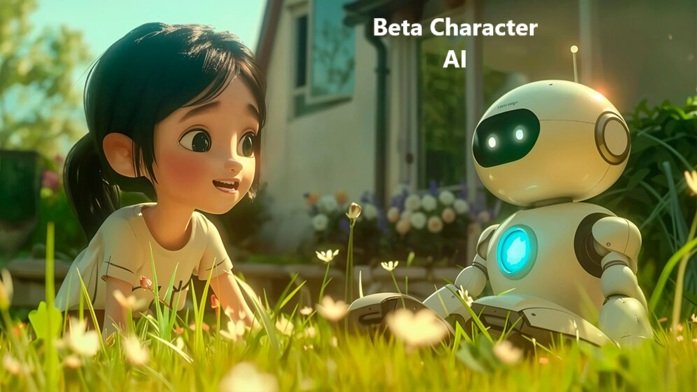Beta Character AI: Revolutionizing Interactive Experiences

Introduction
The digital world is evolving rapidly, and with it, the way we interact with virtual environments and characters. One of the most exciting advancements in this space is Beta Character AI, a sophisticated system that allows for more natural, intelligent, and engaging interactions with virtual characters. Whether in video games, customer service, or storytelling, AI-driven characters are beginning to transform how users engage with technology.
Beta Character AI represents the next generation of artificial intelligence systems designed specifically for interactive experiences. Unlike traditional pre-programmed bots or non-playable characters (NPCs), Beta Character can learn, adapt, and respond to human input in real-time, creating a more immersive and personalized experience.
What is Beta Character AI?
Beta Character AI refers to an AI system designed to control virtual characters in a dynamic and human-like way. These AI characters are often used in gaming, virtual environments, and customer-facing applications to simulate realistic interactions. What sets Beta Character apart is its ability to engage in natural conversations, adapt its responses based on user behavior, and learn from interactions to improve over time.
Traditional NPCs in games or customer service bots usually follow predefined scripts with limited responses. In contrast, Beta Character uses advanced natural language processing (NLP) and machine learning techniques to generate responses that are contextually relevant and can vary depending on how the user interacts with the character.
How Beta Character AI Works
At its core, Beta Character AI is powered by natural language processing (NLP), machine learning, and AI algorithms designed to mimic human behavior. Here’s a closer look at how it functions:
1. NLP for Understanding Conversations
Natural language processing is the backbone of Beta Character ability to comprehend and respond to user inputs. NLP allows the AI to break down the text or voice input into meaningful components, understand the intent, and craft a suitable response.
2. Machine Learning and Adaptability
Unlike static NPCs or bots, Beta Character AI can learn from past interactions. Using machine learning, it continuously refines its responses based on feedback and data patterns. This means the more you interact with a Beta Character, the more it “understands” your preferences, improving the quality of the conversation.
3. AI Models for Realism
Beta Character AI uses complex AI models to simulate realistic human behavior. These models are trained on vast datasets of human conversations, emotions, and behaviors, allowing the AI to respond in a way that feels authentic and emotionally intelligent.
Applications of Beta Character AI
Beta Character AI is revolutionizing several industries, including gaming, customer service, education, and more. Let’s explore some key areas where this technology is making an impact:
1. Gaming Industry and NPC Interactions
In video games, AI-driven characters are transforming the way players experience virtual worlds. NPCs with Beta Character can offer more immersive, unpredictable, and meaningful interactions. These characters can react dynamically to player choices, creating a richer narrative and game experience.
2. Virtual Assistants and Chatbots
Beta Character AI is also being implemented in customer service platforms and virtual assistants. Unlike traditional chatbots that rely on predefined responses, AI-powered characters can offer more personalized and fluid interactions, addressing customer needs in a conversational manner.
3. Education and Training Simulations
In educational settings, Beta Character AI can create interactive simulations where learners can practice real-life scenarios. For example, medical students can engage with AI-driven patients, while business trainees can practice negotiations with virtual clients.
Advantages of Beta Character AI
There are several key benefits to using Beta Character AI in interactive environments. These advantages are driving its growing adoption across multiple sectors.
1. Enhanced User Engagement
One of the most significant advantages of Beta Character AI is its ability to keep users engaged. By creating more realistic and responsive characters, users feel more connected to the experience, whether they’re playing a game or interacting with a virtual assistant.
2. Dynamic and Personalized Responses
Because Beta Character AI learns from interactions, it can offer tailored responses that align with individual user preferences. This level of personalization enhances the overall experience, making it feel unique and customized to the user.
3. Real-Time Learning and Adaptability
Traditional NPCs follow scripted paths, but Beta Character can adapt in real-time. This flexibility allows for dynamic conversations and interactions that evolve based on user input, making each experience different.
Challenges and Limitations of Beta Character AI
Despite its numerous benefits, Beta Character AI faces some challenges and limitations that developers and users must consider:
1. Handling Complex Conversations
While AI has come a long way in understanding and generating human-like responses, handling highly nuanced or complex conversations can still be a challenge. The AI may sometimes struggle to grasp sarcasm, humor, or cultural references, leading to awkward or out-of-context responses.
2. Ethical Concerns with AI Personalities
As AI characters become more realistic, ethical questions arise. Should users form emotional attachments to virtual characters? What happens when AI personalities are used to manipulate users, either for commercial purposes or in gaming environments? Developers need to establish ethical guidelines to prevent misuse.
3. Limitations in Creativity and Originality
While Beta Character AI can create responses based on patterns and past interactions, it is still limited by its programming and data. True creativity and originality, which are hallmarks of human interaction, can sometimes be lacking in AI-driven characters.
Beta Character AI vs Traditional NPCs
The evolution from traditional NPCs to Beta Character AI represents a significant leap forward in how virtual characters are developed and interacted with. Here’s a comparison between the two:
1. Pre-Programmed NPCs
- Scripted Responses: NPCs in traditional games follow a pre-defined set of actions and dialogue that doesn’t change based on player interactions.
- Limited Interactivity: These characters often repeat the same lines or behaviors, leading to predictable and less engaging experiences.
- Fixed Roles: NPCs serve specific functions, like quest givers or enemies, with little room for flexibility or character development.
2. AI-Driven Characters
- Dynamic Conversations: Beta Character AI allows characters to respond fluidly to different user inputs, creating more engaging and unpredictable interactions.
- Increased Interactivity: AI-driven characters can react to player choices and actions in real-time, adding layers of complexity to the gameplay.
- Flexible Roles: Characters powered by Beta Character can evolve over time, changing roles or behaviors based on player interaction, which creates a more immersive environment.
Beta Character AI in Gaming
The gaming industry is one of the biggest beneficiaries of Beta Character AI. As games become more complex, AI-driven characters are essential to creating rich, interactive worlds that respond dynamically to player actions.
1. Evolution of Non-Playable Characters (NPCs)
The evolution of NPCs from simple quest-givers to fully interactive characters marks a significant shift in gaming design. Beta Character AI takes this a step further by allowing NPCs to learn from player behaviors and adapt their actions accordingly.
2. How Beta Character AI Creates Immersive Game Worlds
AI-driven characters can make game worlds feel more alive by offering spontaneous interactions, emotional depth, and unexpected reactions. This level of engagement allows players to feel like they are part of a living, breathing world.
3. Case Studies: Games Using AI-Driven Characters
Several games have started to incorporate AI-driven characters. For example, in Red Dead Redemption 2, NPCs react to the player’s reputation and choices, making the world feel more interactive. As Beta Character continues to evolve, we can expect even more sophisticated AI characters in future titles.
Security and Data Privacy in Beta Character AI
As with any advanced AI technology, Beta Character AI raises important concerns around security and data privacy. Given that AI-driven characters may interact with users on a deeply personal level, managing the vast amounts of data generated by these interactions is crucial to maintaining user trust.
1. How Data is Handled and Stored
One of the primary security concerns with Beta Character is how the data collected during interactions is stored and used. AI-driven systems often require large datasets to function effectively. This means they might collect information such as user preferences, interaction history, and possibly sensitive personal data.
To address these concerns, developers must ensure that data collected by Beta Character is encrypted and stored securely. Additionally, systems should only collect the minimum amount of data necessary to function and should anonymize sensitive data where possible.
2. Ensuring Privacy and User Consent
Users need to be aware of what data is being collected and how it will be used. Transparency is key, and it’s essential for companies using Beta Character AI to provide clear privacy policies and terms of service. Furthermore, consent should be obtained before collecting any personal information.
For developers, building privacy features directly into Beta Character AI systems is a best practice. Users should be able to opt-out of data collection or delete their personal data if they no longer wish to engage with the AI-driven character.
3. Protecting Against Cyber Attacks
Another major concern is the potential for cyber attacks targeting the data and AI systems themselves. Hackers could try to exploit vulnerabilities in the AI’s code or access user data stored within these systems. To mitigate these risks, developers must invest in robust cybersecurity measures, such as regular system updates, multi-layered security protocols, and secure authentication methods.
The Future of Beta Character AI
The future of Beta Character AI holds immense potential, with continued advancements in AI, machine learning, and natural language processing pushing the boundaries of what virtual characters can achieve. Here are some of the key innovations we can expect to see in the coming years.
1. Enhanced Emotional Intelligence
One area where Beta Character AI is poised to improve is in its ability to recognize and respond to human emotions. As AI becomes better at detecting emotional cues in language and facial expressions, virtual characters will be able to provide more empathetic and emotionally intelligent responses. This will lead to more natural, meaningful interactions, whether in gaming, customer service, or other applications.
2. Increased Customization and Personalization
The next generation of Beta Character AI systems will likely offer even more customization options, allowing users to shape the personalities and behaviors of the characters they interact with. This could include selecting the tone or style of communication (e.g., formal or casual), adjusting character traits, or even creating entirely new AI-driven personalities tailored to specific needs.
3. AI-Driven Narratives and Storytelling
In gaming and entertainment, Beta Character AI will play a major role in the creation of interactive, AI-driven narratives. Instead of following a linear story path, players will be able to influence the direction of the plot through their interactions with AI characters. These AI-driven narratives will be highly personalized, offering a unique story experience for each user based on their decisions.
4. AI-Generated Characters in Virtual Reality (VR)
As virtual reality becomes more popular, AI-driven characters will enhance immersive experiences in these digital worlds. In VR games or simulations, Beta Character AI will make interactions feel more lifelike and spontaneous, increasing the sense of presence and immersion. Imagine a VR game where every NPC reacts in real-time to your choices, body language, and even your tone of voice—this is the future of interactive storytelling powered by AI.
How Beta Character AI Improves User Experience
One of the most compelling aspects of Beta Character AI is its ability to create truly personalized and dynamic experiences for users. Whether it’s a player engaging with an AI character in a video game or a customer interacting with an AI assistant, Beta Character enhances the overall experience in several key ways.
1. Emotional Intelligence and Empathy
One of the major advantages of AI-driven characters is their ability to simulate empathy and emotional intelligence. Beta Character AI systems can be programmed to detect user sentiment through language cues, allowing them to respond appropriately to users who are frustrated, happy, or confused. This makes interactions feel more human and helps build a connection between the user and the AI character.
2. Tailored Experiences for Different User Types
Beta Character AI can adjust its responses based on the user’s preferences, making the interaction feel more relevant and personalized. For example, in a gaming environment, an AI character may adapt to a player’s playstyle, offering advice or reacting to decisions in a way that feels tailored to that individual. Similarly, in a customer service scenario, AI assistants powered by Beta Character can provide personalized recommendations based on the user’s past behaviors.
3. Reducing Friction in User Interactions
Because Beta Character AI can understand and predict user needs more effectively than traditional systems, it can help reduce friction in interactions. Users won’t have to repeat themselves or go through unnecessary steps; the AI can anticipate their needs and offer solutions faster. This can be especially helpful in customer service applications, where quick and efficient resolutions are critical to user satisfaction.
How to Get Started with Beta Character AI
Whether you’re a developer looking to integrate Beta Character AI into your platform or a user interested in experiencing AI-driven interactions, getting started with this technology is easier than you might think.
1. Platforms That Support Beta Character AI
Several platforms and development environments already offer support for AI-driven characters. Game engines like Unity and Unreal Engine have plugins and tools that allow developers to incorporate AI characters into their games. Additionally, customer service platforms such as Zendesk and Salesforce are integrating AI-driven chatbots to improve user interaction.
For developers, these platforms provide the tools needed to design and implement AI-driven characters that can interact with users in real-time.
2. Steps for Developers to Integrate Beta Character AI
Developers interested in using Beta Character AI should follow these steps:
- Choose an AI Framework: Start by selecting an AI framework that supports character development, such as OpenAI’s GPT models or Google’s Dialogflow. These frameworks provide the foundation for natural language processing and machine learning capabilities.
- Design Character Personalities: Using the AI framework, developers can design unique personalities for their characters. This involves setting parameters for how the character speaks, reacts, and learns from user interactions.
- Train the AI: To make the AI more effective, it needs to be trained on large datasets of conversations, scenarios, or game interactions. Machine learning models should be fine-tuned to ensure that the AI responds accurately and naturally in different situations.
- Test and Optimize: Once the AI is trained, it’s essential to test it in real-world scenarios. Developers should gather feedback and adjust the AI’s behavior to ensure it’s delivering the desired user experience.
3. User-Friendly AI Platforms
For non-developers who want to explore Beta Character
, several platforms allow users to interact with AI-driven characters without any programming knowledge. Tools like Replika or AI Dungeon provide interactive, conversational AI characters that learn and adapt based on user input. These platforms offer a glimpse into how Beta Character is making conversations with virtual characters more engaging and realistic.
The Role of AI in Storytelling
One of the most exciting applications of Beta Character AI is in the field of interactive storytelling. As AI becomes more sophisticated, it’s poised to revolutionize how stories are told in games, movies, and virtual experiences.
1. AI-Generated Storylines
AI systems are increasingly being used to generate complex storylines that adapt to the user’s choices. In traditional narratives, the storyline is fixed, and players follow a predetermined path. With Beta Character, the story can evolve dynamically based on how the player interacts with AI characters, creating a unique experience every time.
2. Evolving Narratives Based on User Decisions
Beta Character allows narratives to be shaped by user decisions. For example, in a role-playing game (RPG), the choices players make when interacting with AI characters can influence the story’s outcome. This creates a branching narrative structure where the player’s actions determine how the story unfolds.
3. Personalized Storytelling Experiences
As Beta Character learns more about a player’s preferences, it can tailor the story to better match the player’s style and interests. Whether the user prefers action-packed adventures, deep character-driven plots, or humorous side quests, AI-driven characters can adapt the storyline to provide a more personalized experience.
Ethical Considerations in Beta Character AI Development
As with any advanced technology, the development and implementation of Beta Character come with ethical considerations that developers must address.
1. Balancing Realism and Ethical Use of AI
One of the primary ethical concerns is ensuring that AI characters remain ethical in their interactions with users. As AI-driven characters become more realistic, there is a risk that users could form emotional attachments or be manipulated by these characters. Developers need to strike a balance between creating engaging characters and ensuring that these characters don’t exploit user emotions or lead to unhealthy interactions.
2. Ensuring Characters are Free from Harmful Bias
AI systems are only as good as the data they are trained on. If the training data contains biased or harmful content, the AI may inadvertently reflect these biases in its interactions. It’s essential for developers to carefully curate the data used to train AI characters and to regularly monitor the system for any signs of biased or inappropriate behavior.
3. User Control and Transparency
Users should always have control over their interactions with AI characters. This includes the ability to opt-out of conversations, delete interaction history, or modify how the AI character behaves. Transparency about how the AI functions and what data it collects is also crucial in maintaining trust between users and developers.
Conclusion
Beta Character AI is revolutionizing the way we interact with virtual environments, offering more dynamic, personalized, and engaging experiences than ever before. From gaming to customer service, education to storytelling, AI-driven characters are transforming digital experiences by providing more natural, human-like interactions.
As this technology continues to evolve, we can expect even greater advancements in emotional intelligence, customization, and narrative flexibility, allowing users to experience virtual worlds in ways previously unimaginable. However, with these advancements come challenges, particularly around data privacy, ethical concerns, and ensuring AI behaves responsibly.
Also, Read, What is Proxiyum? Exploring the Potential of a New Technology.





